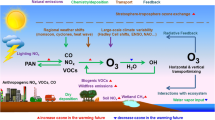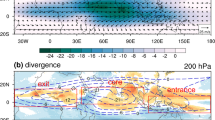Abstract
Using the 5-day averaged data from the National Center for Environmental Prediction/National Center for Atmospheric Research (NCEP/NCAR) reanalysis, and precipitation from rain gauge stations in China for the period 1981–2000, we investigated seasonal variations and associated atmospheric circulation and precipitation of the southwesterly wind over eastern China. The southwesterly wind over eastern China begins earliest over southeastern China and strengthens gradually from spring to the early summer, as it extends northward. The strengthening of the spring southwesterly wind, the tropospheric upward motion, and the convergence of low-level water vapor over southeastern China results in the beginning of the local rainy season. The beginning of the Mei-yu (Plum rainfall) is connected with the northward march of the southwesterly wind. The southwesterly wind reaches the valley of the Yangtze River in the early summer and northern China in the middle summer. This signifies an onset of the large-scale southwesterly wind over eastern China. Accordingly, the rain belt over southeastern China moves to the valley of the Yangtze River in the early summer and to northern China in the middle summer. Moreover, the southerly wind extends southward to the South China Sea from the spring to summer, though it does not stretch from the South China Sea to southeastern China at those times. The strengthening of the southerly wind over southeastern China is associated with a weakening/strengthening of the eastward/westward subtropical tropospheric temperature gradient between southwestern China and the western North Pacific. The developments of a low-pressure system over southwestern China and the subtropical high-pressure system over the western North Pacific may contribute to the strengthening of the southwesterly wind. A northward advance of the high-pressure system favors the southwesterly wind stretching from southeastern China to northern China. The onset of the Indian summer monsoon also strengthens the summer southwesterly wind over eastern China.












Similar content being viewed by others
References
Chan J-C-L, Wang Y-G, Xu X-J (2000) Dynamic and thermodynamic characteristics associated with the onset of the 1998 South China Sea summer monsoon. J Meteor Soc Jpn 78:367–380
Chang C-P, Chen G-T (1995) Tropical circulations associated with southwest monsoon onset and westerly surges over the South China Sea. Mon Weather Rev 123:3254–3267
Chang C-P, Hou S-C, Kuo H-C, Chen G-T-J (1998) The development of an intense East Asian summer monsoon disturbance with strong vertical coupling. Mon Weather Rev 126:2692–2712
Chang C-P, Yi L, Chen G-T (2000) A numerical simulation of vortex development during the 1992 East Asian summer monsoon onset using the Navy’s regional model. Mon Weather Rev 128:1604–1631
Chen L-X, Li W, Zhao P, Tao S-Y (2001) On the process of summer monsoon onset over East Asia. Acta Meteorol Sin 15:436–449
Chen L-X, Zhu Q-G, Luo H-B (1991) East Asian monsoons (in Chinese). Chinese Meteorological Press, Beijing, pp 1–362
Chou C (2003) Land–sea heating contrast in an idealized Asian summer monsoon. Clim Dyn 21:11–25
Dao S-Y, Chen L-S (1957) The structure of general circulation over continent of Asia in summer. J Meteor Soc Jpn 75th Ann Vol, pp 215–229
Ding H (2004) Seasonal march of the East-Asian summer monsoon. In: Chang C-P (ed) East Asian monsoon. World Scientific, Singapore, pp 3–53
Ding H, Liu Y-J (2001) Onset and the evolution of the summer monsoon over the South China Sea during SCSMEX field experiment in 1998. J Meteor Soc Jpn 79:1119–1137
Duan A-M, Wu G-X (2005) Role of the Tibetan Plateau thermal forcing in the summer climate patterns over subtropical Asia. Clim Dyn 24:793–807
Flohn H (1957) Large-scale aspects of the “summer monsoon” in South and East Asia. J Meteor Soc Jpn 75th Ann Vol, pp 180–186
Jhun JG, Lee EJ (2004) A new East Asian winter monsoon index and associated characteristics of the winter monsoon. J Clim 15:711–726
Kalnay E, Coauthors (1996) The NCEP/NCAR 40-year reanalysis project. Bull Am Meteor Soc 77:437–471
Lau K-M, Li M-T (1984) The monsoon of East Asia and its global associations—a survey. Bull Am Meteor Soc 65:114–125
Lau K-M, Yang S (1997) Climatology and interannual variability of the Southeast Asian summer monsoon. Adv Atmos Sci 14:141–161
Li C, Yanai M (1996) The onset and interannual variability of the Asian summer monsoon in relation to land–sea thermal contrast. J Clim 9:358–375
Lu E, Chan J-C (1999) A unified monsoon index for South China. J Clim 12:2375–2385
Matsumoto J (1997) Seasonal transition of summer rainy season over Indochina and adjacent monsoon region. Adv Atmos Sci 14:232–245
Murakami T, Matsumoto J (1994) Summer monsoon over the Asian continent and western North Pacific. J Meteor Soc Jpn 72:719–745
Nikaidon Y (1989) The PJ-like North–South oscillations found in 4-month integrations of the global spectral model T42. J Meteor Soc Jpn 67:587–604
Ninomiya K, Murakami T (1987) The early summer rainy season (Baiu) over Japan. In: Chang CP, Krishnamurti TN (eds) Monsoon meteorology. Oxford University Press, New York, pp 93–121
Nitta T (1987) Convective activities in the tropical western Pacific and their impacts on the Northern Hemisphere summer circulation. J Meteor Soc Jpn 65:373–390
Ramage CS (1971) Monsoon meteorology. Academic, New York, pp 296
Staff Members of the Section of Synoptic, Dynamic Meteorology, Institute of Geophysics and Meteorology, Academia Sinica, Peking (1957) On the general circulation over eastern Asia (I). Tellus 9:432–446
Suda K, Asakura T (1955) A study on the unusual “Baiu” season in 1954 by means of Northern Hemisphere upper air mean charts. J Meteor Soc Jpn 33:233–244
Tian S-F, Yasunari T (1998) Climatological aspects and mechanism of spring persistent rains over central China. J Meteor Soc Jpn 76:57–71
Tao S-Y, Chen L-X (1987) A review of recent research on the East Asian summer monsoon in China. In: Chang C-P, Krishnamurti TN (eds) Monsoon meteorology. Oxford University Press, New York, pp 60–92
Wang B, Lin H (2002) Rainy season of the Asian-Pacific summer monsoon. J Clim 15:386–398
Webster PJ, Magaña VO, Palmer TN, Shukla J, Tomas RA, Yanai M, Yasunari T (1998) Monsoon: processes, predictability, and the prospects for prediction. J Geophys Res 103:14451–14510
Wu G-X, Zhang Y (1998) Tibetan Plateau forcing and the timing of the monsoon onset over South Asia and the South China Sea. Mon Weather Rev 126:913–927
Yanai M, Li C, Song Z (1992) Seasonal heating of the Tibetan Plateau and its effects on the evolution of the Asian summer monsoon. J Meteor Soc Jpn 70:319–351
Ye D, Gao Y-X (1979) The Meteorology of the Qinghai-Xizang (Tibet) Plateau (in Chinese). Science Press, Beijing pp 1–278
Zhao P, Sun J, Zhou X-J (2003) Mechanism of formation of low level jets in the South China Sea during spring and summer of 1998. Chin Sci Bull 48:1265–1270
Acknowledgments
We are grateful to the editor, Prof. E. K. Schneider, and the anonymous reviewers for their helpful comments and suggestions that greatly improved the manuscript. We also thank the NOAA’s Climate Diagnostic Center for providing the NCEP/NCAR reanalysis data available. This work was jointly sponsored by the National Key Basic Research Project of China (2004CB418302), the National Scientific and Technological Infrastructure and Facility Development Project of China (2003DIB3J120), and the National Natural Science Foundation of China (40625014).
Author information
Authors and Affiliations
Corresponding author
Rights and permissions
About this article
Cite this article
Zhao, P., Zhang, R., Liu, J. et al. Onset of southwesterly wind over eastern China and associated atmospheric circulation and rainfall. Clim Dyn 28, 797–811 (2007). https://doi.org/10.1007/s00382-006-0212-y
Received:
Accepted:
Published:
Issue Date:
DOI: https://doi.org/10.1007/s00382-006-0212-y




